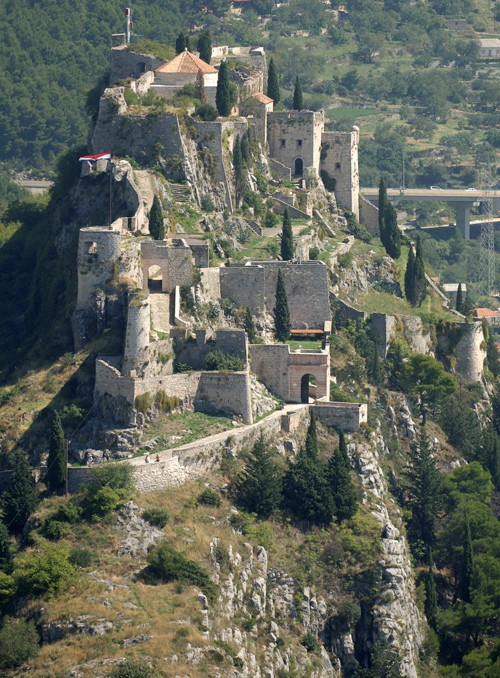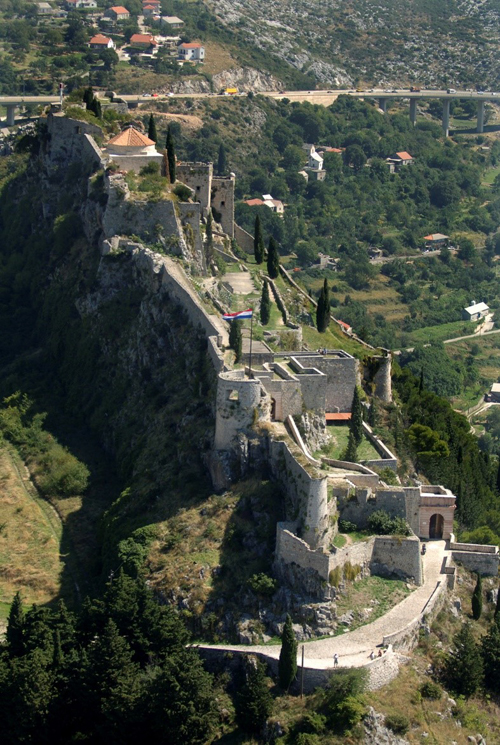The dynamic history and numerous dramatic turns of fate at the Klis fortress is one of the most famous and best-preserved late medieval forts and Baroque fortifications in Croatia, undoubtedly the result of its very special location.
It was built on a steep and inaccessible cliff in the narrow rocky gorge that separates the mountains of Kozjak and Mosor. The gorge has paved the way for communication between the Adriatic coast, the Zagora amongst the deep Croatian and Bosnian hinterland.
Today, modern roads are built in the same direction, significantly the geographical position having strategic importance to rulers and conquerors of yesteryear. Without including the prehistoric remains of human habitation found in the nearby caves, the fortification of the Illyrian tribe of Dalmatae from the 2nd century BC is considered to be the oldest in the Klis area. Although a Roman military fortress with a guard stand over the town of Salona, the constantly guarded Kleisa succumbed to the Alvar-Slavic invasion in 614.
In the same year, these Asian warriors conquered Salona. Konstantin Porfirogenet wrote about this event in 950 in which he recalled Klis later became the centre of the old Croatian coastal parish (or Parathalasie). The existence of the fortress had been documented even earlier, in the Charter of the prince Trpimir from 852, in which it was mentioned as the Croatian court (curtis). For the next seven centuries, the Klis fort had been in the hands of Croatian and Croatian-Hungarian rulers. In the mid 13th century, it had successfully defended against the Mongol invasion during which Bela IV had retreated within its walls, but at the beginning of the 16th century, it yielded to the Turks.
Throughout the 25 year Turkish occupation, the Croatian resistance was overseen by the then Captain and Duke Petar Kruzic, one of the most featured personalities in Croatian history managing to resist the onslaught of attacks of unrelenting and well manned Turkish forces.
On the 12th March 1537, the Croatian resistance was defeated by Turkish forces and the unfittingly the demise of Petar Kruzic.
The news spread over the Croatian borders as a tragic and significant event – the Turkish forces had an open path to the West.
After that, the Turks held here a stronghold for more than a century and the river Jadro separated the Turkish from the Venetian territory.
After several attempts of Croatian patriots and one short term success to liberate the fortress from the Turks, on the 31st of March 1638 the Venetian commander Leonardo Foscolo led his ranks to one of the greatest Venetian victories during the war of Candia. During the Venetian administration, the Klis fortress was restored and renovated. With the fall of the Venetian Republic, it enters the last phase of changes during which it served various armies: the Austrians, the French, the Kingdom of Serbs, Croats and Slovenes, Yugoslavia and the occupants in the World War II. Today, the Croatian flag flutters on the top of its highest tower.
Architecturally, the fortress is surrounded by three defensive stone walls. The main entrance has a monumental Baroque gate on the west side of the first enclosure. On the same side, but from within, next to the second entrance, there is the tower Oprah - once the most important medieval strongholds and the artillery barrack built by the Austrians. The third wall is the highest of all Klis fortifications. It is situated on the east, on the foundations of what was once an Illyrian inhabitation and then a Roman camp. In the mid 17th century, the Venetians built there the proveditor’s residence, which was reconstructed by the Austrians and converted into the military-engineering command. There is also the church of St. Vid, which was built over a Turkish mosque during the Venetian dominion.
The complex of the Klis fortress includes the historical, sacred and secular monuments situated in its hinterland and on the foothill, which makes it an extremely important cultural and historical site. It is an endless source of artistic inspiration and initiative for conservation, restoration and cultural promotion. MedPaths is participating in the project of establishing a multimedia museum on the premises of the Klis fortress and making it the central axis of all the visits to the County by converting the proveditor’s apartment into the residential area of Split-Dalmatia County prefect.

